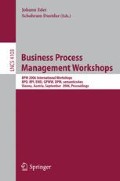Abstract
Almost at every tier of software architecture, business rules crosscut several parts of process management such as workflows, task assignments, and business transactions. Managing business rules on its own hence improves the dynamism of processes in the sense of modeling, implementing, executing, and even maintenance. Moreover, seamless integration with the rest of the picture may offer further dynamism, but this requires smart and reasonably reflective application frameworks for industrial systems. Here, aspect orientation comes to rescue since it mainly aims the separation of crosscutting concerns such as business rules. This paper presents a practical Aspect-Oriented Framework for rule-based business process management where all aspects, facts, rules and rule-sets can be defined and managed dynamically by means of a GUI console. Moreover, this lightweight framework has been implemented in conformance to Adaptive Object Model to facilitate the process dynamism through declarative techniques for design and bytecode engineering for seamless integration.
Access this chapter
Tax calculation will be finalised at checkout
Purchases are for personal use only
Preview
Unable to display preview. Download preview PDF.
References
Aksit, M., Tekinerdogan, B.: Aspect-Oriented Programming Using Composition Filters. In: Demeyer, S., Bosch, J. (eds.) ECOOP 1998 Workshops. LNCS, vol. 1543, p. 435. Springer, Heidelberg (1998)
Altintas, N.I., Cetin, S.: Integrating a Software Product Line with Rule-Based Business Process Modeling. In: Draheim, D., Weber, G. (eds.) TEAA 2005. LNCS, vol. 3888, pp. 15–28. Springer, Heidelberg (2006)
Altintas, N.I., Surav, M., Keskin, O., Cetin, S.: Aurora Software Product Line. In: Turkish Software Architecture Design Workshop, 2nd National Software Engineering Symposium, Ankara – Turkey (2005), http://trese.cs.utwente.nl/TSAD/Papers/aurora.pdf
Bajec, M., Krisper, M., Rupnik, R.: Using Business Rules Technologies To Bridge The Gap Between Business And Business Applications. In: Proceedings of the IFIP 16th World Computer Congress, pp. 77–85 (2000)
Buschmann, F., et al.: Pattern-Oriented Software Architecture. In: A System of Patterns, vol. 1. John Wiley & Sons, Chichester (1996)
Cibran, M., D’Hondt, M.: High-Level Specification of Business Rules and Their Crosscutting Connections. In: AOSD 2006 (2006)
D’Hondt, M.: Hybrid Aspects for Integrating Rule-Based Knowledge and Object-Oriented Functionality, Ph.D. Thesis, Vrije Universiteit, Brussel (2004)
Dantas, A., Borba, P.: Adaptability Aspects: An Architectural Pattern for Structuring Adaptive Applications. In: SugarLoaf- PLoP 2003, Brazil (2003)
Date, C.J.: What Not How: The Business Rules Approach To Application Development. Addison Wesley Longman, Inc., Amsterdam (2000)
Elrad, T., Aksit, M., Kiczales, G., Lieberherr, K., Ossher, H.: Discussing Aspects of AOP. Communications of the ACM 44, 33–38 (2001)
Fayad, M., Schmidt, D., Johnson, R.: Building Application Frameworks: Object-Oriented Foundations of Framework Design. John Wiley & Sons, Chichester (1999)
Fowler, M.: Patterns of Enterprise Application Architecture. Addison-Wesley, Reading (2002)
Gamma, E., et al.: Design Patterns: Elements of Reusable Object-Oriented Software. Addison-Wesley, Reading (1994)
Harrison, W.H., Ossher, H.L., Tarr, P.L.: Asymmetrically vs. Symmetrically Organized Paradigms for Software Composition, IBM Research Division, RC22685 (2002)
Herbst, H.: Business Rules in Systems Analysis: A Meta-Model and Repository System. Information Systems 21(2), 147–166 (1996)
IBM: HyperJ: Multi-Dimensional Separation of Concerns for Java, (2001), http://www.research.ibm.com/hyperspace/HyperJ/HyperJ.htm
Kiczales, G.: Aspect-Oriented Programming. ACM Computing Survey 4, 157 (1996)
Kiczales, G., Lamping, J., Mendhekar, A., Maeda, C., Lopes, C.V., Loingtier, J.M., Irwin, J.: Aspect–Oriented Programming. In: Aksit, M., Matsuoka, S. (eds.) ECOOP 1997. LNCS, vol. 1241, pp. 220–242. Springer, Heidelberg (1997)
Mohan, C.: Recent Trends in Workflow Management Products, Standards and Research, vol. 164, pp. 396–409 (1998), http://www.almaden.ibm.com/cs/exotica/wfnato97.ps
Moriarty, T.: Business Rule Management Facility: System Architect. Intelligent Enterprise 3(12) (2000)
Northeastern University, College of Computer and Information Science: DemeterJ: Aspect-Oriented Software Development (1996), http://www.ccs.neu.edu/home/lieber/demeter.html
Parnas, D.L.: On the Criteria to be used in Decomposing Systems into Modules. Communications of the ACM 15(12), 1053–1058 (1972)
Ramnivas, L.: AspectJ in Action, Practical Aspect-Oriented Programming (2003)
Smith, H., Fingar, P.: Business Process Management (BPM): The Third Wave. Meghan-Kiffer Press (2003)
Struck, D.L.: Business Rule Continuous Requirements Environment, PhD Thesis, Colorado Technical University (1999)
Tufekci, O., Cetin, S., Altintas, N.I.: How to Process [Business] Processes, Integrated Design and Process Technology. In: IDPT 2006, Society for Design and Process Science (2006), http://www.cybersoft.com.tr/free/publications/H2PP.pdf
Yoder, J.W., Balaguer, F., Johnson, R.: Adaptive Object Models for Implementing Business Rules. In: OOPSLA (2001)
Yoder, J.W., Balaguer, F., Johnson, R.: Architecture and Design of Adaptive Object Models. In: Intriguing Technology Presentation at OOPSL 2001. ACM SIGPLAN Notices. ACM Press, New York (2001)
Author information
Authors and Affiliations
Editor information
Editors and Affiliations
Rights and permissions
Copyright information
© 2006 Springer-Verlag Berlin Heidelberg
About this paper
Cite this paper
Cetin, S., Altintas, N.I., Solmaz, R. (2006). Business Rules Segregation for Dynamic Process Management with an Aspect-Oriented Framework. In: Eder, J., Dustdar, S. (eds) Business Process Management Workshops. BPM 2006. Lecture Notes in Computer Science, vol 4103. Springer, Berlin, Heidelberg. https://doi.org/10.1007/11837862_20
Download citation
DOI: https://doi.org/10.1007/11837862_20
Publisher Name: Springer, Berlin, Heidelberg
Print ISBN: 978-3-540-38444-1
Online ISBN: 978-3-540-38445-8
eBook Packages: Computer ScienceComputer Science (R0)

